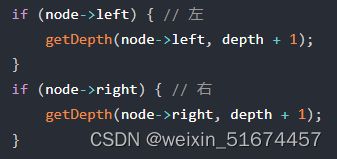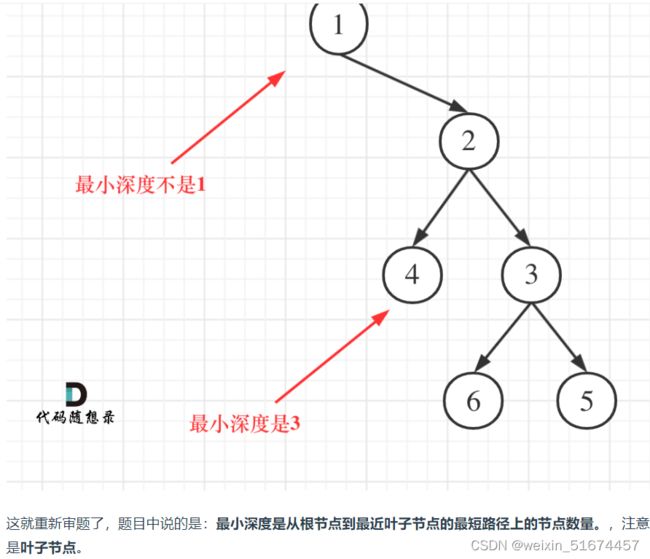代码随想录算法训练营第16天 | 二叉树part03:● 104.二叉树最大深度 559.n叉树最大深度● 111.二叉树最小深度● 222.完全二叉树节点个数
104 二叉树最大深度
几种方法
1 dfs 递归 前中后序模板法 是直接求depth
一些发现:if (node->left ! = nullptr)可以直接写做 if (node->left);可以在class里统一写一个var就不用用ref传来传去了
class Solution {
public:
int result;
void getdepth(TreeNode* node, int depth) {
result = depth > result ? depth : result; // 中
//if (node->left == NULL && node->right == NULL) return ;
if (node->left) getdepth(node->left, depth + 1);
if (node->right) getdepth(node->right, depth + 1);
}
int maxDepth(TreeNode* root) {
result = 0;
if (root == 0) return result;
getdepth(root, 1);
return result;
}
};新学到的一点是:才意识到右边是左边的详细逻辑,就是思考上要考虑到回溯的过程
2 dfs 递归后序另一种写法是通过求root的高度来求树的最大深度
- 节点深度:root到node的最长简单路径边的条数或者节点数(取决于深度从0开始还是从1开始)
- 节点高度:node到leaf的最长简单路径边的条数或者节点数(取决于高度从0开始还是从1开始)
root高度就是二叉树的最大深度
class solution {
public:
int getdepth(TreeNode* node) {
if (node == NULL) return 0;
int leftdepth = getdepth(node->left); // 左
int rightdepth = getdepth(node->right); // 右
int depth = 1 + max(leftdepth, rightdepth); // 中
return depth;
}
int maxDepth(TreeNode* root) {
return getdepth(root);
}
};3 迭代法的话适合bfs那种层序的(不是dfs的迭代),直接套模板
559.n叉树的最大深度
也是分为递归dfs(只有一种了)和bfs层序遍历
dfs:
void order(Node* node, int depth, int&max){
if(node==nullptr) return;
vector clist=node->children;
max=std::max(max,depth);
for(auto ele:clist){
order(ele, depth+1, max);
}
}
int maxDepth(Node* root) {
int depth=1;
int max=0;
order(root,depth,max);
return max;
} 更简洁的:
int maxDepth(Node* root) {
if (root == 0) return 0;
int depth = 0;
for (int i = 0; i < root->children.size(); i++) {
depth = max (depth, maxDepth(root->children[i]));
}
return depth + 1;
}bfs迭代
nt maxDepth(Node* root) {
queue que;
if (root != NULL) que.push(root);
int depth = 0;
while (!que.empty()) {
int size = que.size();
depth++; // 记录深度
for (int i = 0; i < size; i++) {
Node* node = que.front();
que.pop();
for (int j = 0; j < node->children.size(); j++) {
if (node->children[j]) que.push(node->children[j]);
}
}
}
return depth;
} 111 二叉树最小深度
易错点:注意对最小深度的定义
本题关键:左右孩子都为空的节点才是叶子节点,才能算一个path的结束
方法包括:层序遍历的迭代(走到第一个叶子节点就可得出答案退出了),dfs模板的前中后序(直接算depth),和通过算高度的后序dfs 【和104一样的 对应的这些方法】
模板和迭代在上一篇写了这里就不写了,后序求高度写一下:
int minDepth(TreeNode* root) {
if (root == NULL) return 0;
if (root->left == NULL && root->right != NULL) {
return 1 + minDepth(root->right);
}
if (root->left != NULL && root->right == NULL) {
return 1 + minDepth(root->left);
}
return 1 + min(minDepth(root->left), minDepth(root->right));
}222 完全二叉树节点的个数
思路1:直接按照普通二叉树做
层序遍历的迭代:直接套模板
int countNodes(TreeNode* root) {
queue que;
if (root != NULL) que.push(root);
int result = 0;
while (!que.empty()) {
int size = que.size();
for (int i = 0; i < size; i++) {
TreeNode* node = que.front();
que.pop();
result++;
if (node->left) que.push(node->left);
if (node->right) que.push(node->right);
}
}
return result;
} 前中后序递归:
void order(TreeNode* node, int& cnt){
if(node==nullptr) return;
cnt++;
if(node->left!=nullptr) order(node->left,cnt);
if(node->right!=nullptr) order(node->right,cnt);
}
int countNodes(TreeNode* root) {
int cnt=0;
order(root,cnt);
return cnt;
}后序递归:
int getNodesNum(TreeNode* cur) {
if (cur == NULL) return 0;
int leftNum = getNodesNum(cur->left); // 左
int rightNum = getNodesNum(cur->right); // 右
int treeNum = leftNum + rightNum + 1; // 中
return treeNum;
}
int countNodes(TreeNode* root) {
return getNodesNum(root);
}
思路二:用完全二叉树的性质来做
完全二叉树只有两种情况,1:满二叉树,2:最后一层叶子节点没有满。
1,可以直接用 2^depth - 1 来计算,注意这里根节点深度为1。先求出depth即可
2,分别递归左/右孩子,递归到某深度一定会有左/右孩子为满二叉树,然后依照情况1来计算。
判断一个左子树或者右子树是不是满二叉树呢? 在完全二叉树中,如果递归向左遍历的深度等于递归向右遍历的深度,那说明就是满二叉树
int countNodes(TreeNode* root) {
if (root == nullptr) return 0;
TreeNode* left = root->left;
TreeNode* right = root->right;
int leftDepth = 1, rightDepth = 1; //注意下面计算node个数一定深度要从1开始
while (left) {
left = left->left;
leftDepth++;
}
while (right) {
right = right->right;
rightDepth++;
}
if (leftDepth == rightDepth) return pow(2,leftDepth)-1;
return countNodes(root->left) + countNodes(root->right) + 1;
}另一种写法,先初始化为0,然后 写return (2 << leftDepth) - 1; // 注意(2<<1) 相当于2^2,返回满足满二叉树的子树节点数量




